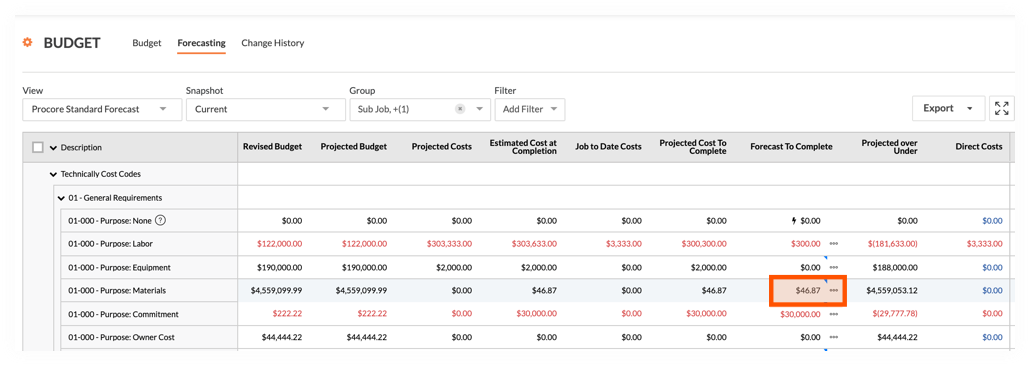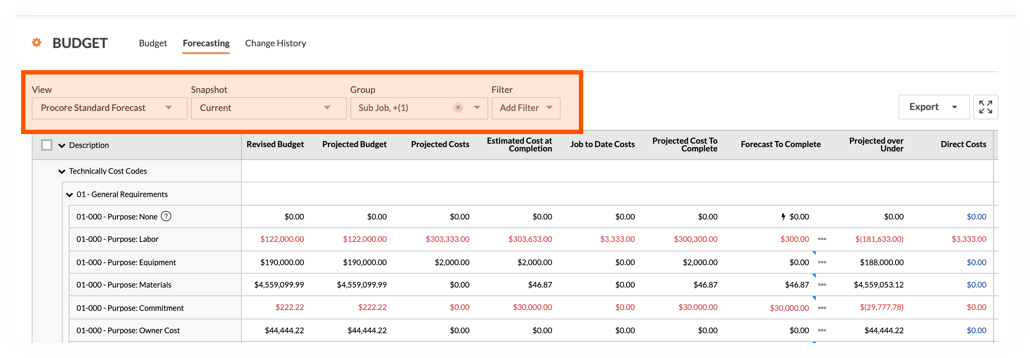Project Financials: Advanced Forecasting Available by Default
This announcement represents a single point in time. Future releases may impact the information below.
Feature Announced: Wednesday, February 10, 2021 / Feature Released: April 20, 2021 / Announcement Updated: May 18, 2021
Advanced Forecasting Features Now Available by Default
Procore's Advanced Forecasting features have been turned ON in your project's Budget tool by default. This feature was initially announced and released in 2020 (see Project Financials: Advanced Forecasting for the Budget Tool) and was previously only available to customers who specifically requested that it be turned ON. Now, it will be available to all Project Financials users by default.
What is included in this release?
With Advanced Forecasting, your company can help project teams evaluate current and future budget conditions by:
- Creating customized advanced forecasting views and assigning those views to project budgets
Your company's Procore Administrator can create customized forecasting templates using the system's default 'Procore Standard Forecast' view (see About the Procore Standard Forecast View) in the Company level Admin tool pictured below. The steps for configuring columns and assigning the view to projects is similar to the steps used to create budget views—but specifically tailored for use with a new Forecasting tab which is available in the Budget tool. For instructions, see Set Up a New Forecasting View.

- Setting a Start Date, End Date, and applying a curve to each cost code on the forecast view budget
Once your forecasting view is assigned to a project, your users have the ability to project your project's monthly costs across each budget line item. Costs can be spread over four (4) curves: Linear, Back Loaded, Front Loaded, and Bell. You can also type the forecast amounts you want into the monthly forecast columns of a budget line item to enter 'Manual' entry mode. This lets you set a specific value for each month's cost projection on the budget line item's monthly spread columns.

- Inline editing on the Forecast to Complete value of a budget line item to quickly balance the forecast's monthly spread
To better help users balance their monthly spread values against the Forecast to Complete value, users can now apply a new Lump Sum Entry calculation method by typing a value inline. As with other Procore tools, fields that allow inline editing are marked in the top-right corner with a blue caret symbol. This allows users to manually edit each budget line item’s spread, which is helpful when you want to quickly enter an amount to balance the 'Remaining' value to zero (0).

- Bulk editing and importing forecasts to quickly update line item data
In addition, users can perform bulk updates to change the start date, end date, and curve. Users can also import start dates, end dates, and curves using the budget import template. See Import a Budget.

- Filtering and grouping data in the forecasting view
Users can also apply existing 'Actuals by Date' and 'Forecast Start Date' filters available with Procore’s budget views to the forecasting view. To learn about these filters, see Apply the View, Snapshot, Group, and Filter Options on a Budget or Forecasting View.

How do I turn Advanced Forecasting ON?
You don't need to. Advanced Forecasting will be turned ON automatically in all new and existing Procore projects. This allows you to immediately begin using the Procore Standard Forecast View (see About the Procore Standard Forecast View). You can also create your own customized forecasting views to use with the budget. For instructions, see Set Up a New Forecasting View.
How do I turn Advanced Forecasting OFF?
If you decide you don't want to use advanced forecasting on a project, a user with 'Admin' level permission on the Project level Budget tool can simply clear the Enable Advanced Forecasting checkbox in the Configure Settings page. See Configure Advanced Settings: Budget.
How do I use Advanced Forecasting?
To learn how to use this feature, see Apply Advanced Forecasting Curves.
See Also
- About the Procore Standard Forecast View
- Set Up a New Forecasting View
- Apply Advanced Forecasting Curves
If you would like to ask questions or share any feedback, please contact support@procore.com.

